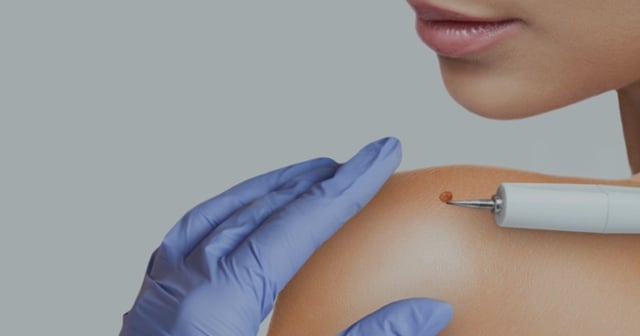

Warts Medical Services
in Grand Rapids, MI
What Are Warts?
Warts are raised, skin-colored growths that can develop almost anywhere on the body and may resemble a cauliflower or solid blister. Most warts are completely harmless, but people often consider wart removal for a variety of reasons, including embarrassment and wanting to avoid spreading them to others.
What Causes Warts?
A group of viruses called the human papillomavirus (HPV) causes warts. When your skin is infected with one of the viruses in the HPV family, it triggers the excessive growth of skin cells. This makes the outer layer of your skin appear thickened and hard in that specific area.
REQUEST NOWWho Gets Warts?
Warts are highly contagious and spread easily from person to person. It’s possible to get warts simply by touching a wart on another person’s body. You can even get warts from touching a surface or object that’s been in contact with a wart, including towels.
Anyone at any age can get warts, but children and teens are more likely to develop them. If you have a weakened immune system, you’re at a higher risk of developing warts. If you have any cuts or scrapes on your skin, it’s easy for the HPV virus to enter. This also explains why people who bite their nails or pick at hangnails are susceptible to warts.
Types of Warts
There are several types of warts, and our Forefront dermatologists determine the type of wart you have based on its appearance and where it appears on your body. Here’s a closer look at some of the different types of warts.
Common wart: This type of wart is usually small and feels like a rough bump. They’re most often found on the fingers, the backs of hands, and the skin around your nails. A common wart is typically flesh-colored, but it can also have black dots that look similar in appearance to seeds. These are actually tiny blood clots, which can lead to bleeding.
Flat wart: Flat warts are typically smoother in appearance and smaller in comparison to other types, although they tend to grow in large numbers. It’s not uncommon to have 20–100 flat warts at a time. These warts are commonly found on women’s legs, children’s faces, and men’s beard areas.
Plantar wart: Plantar warts develop on the soles of your feet. They are flat in appearance and grow into your skin due to the pressure from walking and standing. This inward growth can make it feel like you have pebbles in your shoe. Like common warts, plantar warts can also have black dots, and they usually grow in clusters.
Filiform wart: These warts often grow quickly and typically develop around your mouth, eyes, and nose. Filiform warts have a spiky or thread-like appearance.
Periungual wart: Periungual warts develop under or around the fingernails and toenails. Although they start out small, they can grow to become a rough bump.

Treatment Options for Wart Removal
Most warts will go away without resorting to wart removal methods. This is especially true for children, but it can be more difficult for warts to disappear in adults. Without wart treatment, it can take between one to five years for them to go away.
If you have numerous warts, if a wart hurts, or if you can’t get rid of a wart on your own, you should see your Forefront dermatologist who will recommend the best wart removal method for you. Treatment depends on the type of wart you have and its location on your body. Our highly skilled Board-Certified dermatologists offer many treatment options for warts.
These are some of the best wart removal options recommended by our dermatologists:
Cryotherapy is one of the most common wart treatment options. This treatment freezes off the wart with liquid nitrogen, but more than one treatment is usually needed.
Excision: Your dermatologist will cut the wart out of your skin.
Electrosurgery: This option involves burning the wart with an electric charge delivered through a laser or the top of a needle.
Curettage: Your dermatologist scrapes off the wart with a small tool shaped like a spoon or a sharp knife.
Cantharidin: This is a liquid treatment that’s applied over a wart, causing a blister to form underneath. After the blister dries, which takes about a week, your dermatologist can clip away the wart.
Laser treatment involves burning off the wart with a laser.
Chemical peels: An effective treatment for flat warts, a chemical peel involves applying a peeling medication to the skin, which gently removes warts from the top layer of skin.
Antigen shots boost your immune system, which helps your body fight the virus that causes warts.
Photodynamic therapy uses wavelengths of blue light and medications called photosensitizing agents to destroy warts.
Liquids, gels, and pads containing salicylic acid work by gently exfoliating skin cells until the wart gradually disappears.
Duct tape: This home remedy for warts involves covering the wart in duct tape. By changing the tape every few days, it’s possible to remove some of the wart’s layers.
1 Location in the Grand Rapids, MI area
Interested in Warts? Request a consultation with a skin specialist today.
*Treatment options may vary at each location.Please confirm your desired treatment is offered at your preferred location when scheduling. *Age Restriction.
For patients scheduling who are under 18 years of age (19 in Alabama) please make sure you have permission from your parent or legal guardian to schedule this appointment. Your parent or legal guardian must accompany you on your initial visit and on certain subsequent visits to provide appropriate informed consent.